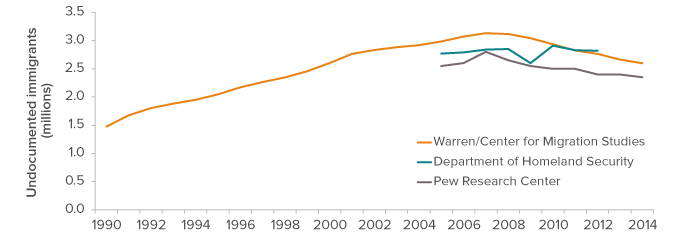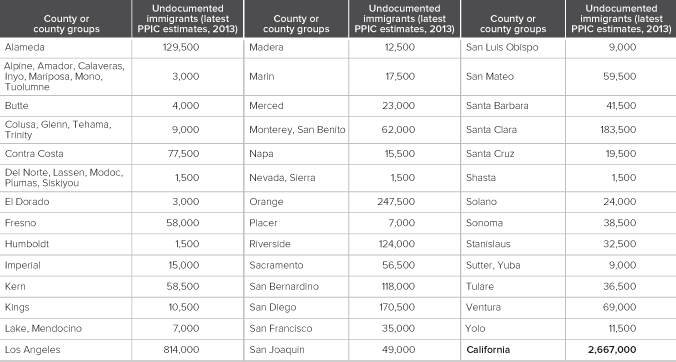- California is home to more than two million undocumented immigrants.
Undocumented (also known as illegal or unauthorized) immigrants are not directly identified in any representative national or state surveys. But the best estimates suggest that in 2014, the year of the most recent data available, California was home to between 2.35 and 2.6 million undocumented immigrants. Nearly a quarter of the nation’s undocumented immigrants reside in California, where they constitute more than 6% of the state’s population. Nationally, the undocumented population has stabilized at approximately 11 million, following a slight decline after 2007. A combination of increased enforcement, voluntary returns, and fewer new migrants has increased the average length of residence in the United States, with 66% of undocumented immigrants having lived here for 10 or more years.
The undocumented population in California appears to be declining

SOURCES: Annual estimates of the undocumented population by Robert Warren, working alone or with the Center for Migration Studies, the Department of Homeland Security, and the Pew Research Center.
- Most undocumented immigrants are from Latin America.
Nationwide, 78% of undocumented immigrants are from Latin America—a slight majority (52%) come from Mexico alone. Most of the others (13%) are from Asia, although Africa and Europe also account for hundreds of thousands of undocumented immigrants in the US. The Pew Research Center (PRC) estimates that as of 2014, 71% of California’s undocumented population was Mexican-born. - Nearly one in ten California workers is an undocumented immigrant.
California’s labor force includes about 1.75 million undocumented immigrants, according to the PRC. This is the second-highest statewide concentration of undocumented workers (9.0%) in the US after Nevada (10.4%). Undocumented immigrants work disproportionately in agriculture, construction, and manufacturing. - Many undocumented immigrants live with family members who are citizens.
More than 5 million children in the US have an undocumented parent, according to estimates from the Migration Policy Institute, and most of these children (79%) are US citizens. It is likely that 12.3% of California’s K–12 school children have an undocumented parent, according to PRC estimates. Nationally, more than 750,000 young people have received deportation relief and work permits through a federal program called Deferred Action for Childhood Arrivals (DACA), which confers legal status upon those who came to the US as undocumented children. More than 200,000 DACA recipients live in California, according to the US Citizenship and Immigration Services. The future of the DACA program is very much uncertain. President Trump has sent mixed signals, while some members of Congress have vowed to fight for the program. - Counties vary in their sanctuary policies for undocumented immigrants.
Some California city and county leaders have stated that they will provide sanctuary for undocumented immigrants—this refers to limiting local assistance to federal immigration enforcement. However, no sanctuary policy can universally prevent deportations. Further, county jails provide the FBI with fingerprints from all bookings, which the FBI then sends to Immigration and Customs Enforcement. Even if individual cities have a sanctuary policy, county law enforcement supersedes city policies if undocumented immigrants are placed in county jails.
Populations of undocumented immigrants vary across counties

SOURCES: Authors’ calculations using IRS tax data from the Brookings Institution, population data from the American Community Survey, and statewide undocumented population estimates from the Center for Migration Studies. These 2013 estimates are PPIC’s most recent estimates. Estimates for the state by Center for Migration Studies suggest a slight decline from 2013 to 2014 (2.6%).
- A majority of Californians back a path to legal status.
Since January 2016, the PPIC Statewide Survey has asked Californians four times whether “there should be a way for [undocumented immigrants] to stay in the country legally, if certain requirements are met.” Each time, 82% or more have supported this idea. In January 2017, 65% of adults favored the idea of “California state and local governments making their own policies and taking actions, separate from the federal government, to protect the legal rights of undocumented immigrants in California,” but support varied widely along party lines: 80% of Democrats, 27% of Republicans, and 59% of independents.
Topics
Population




